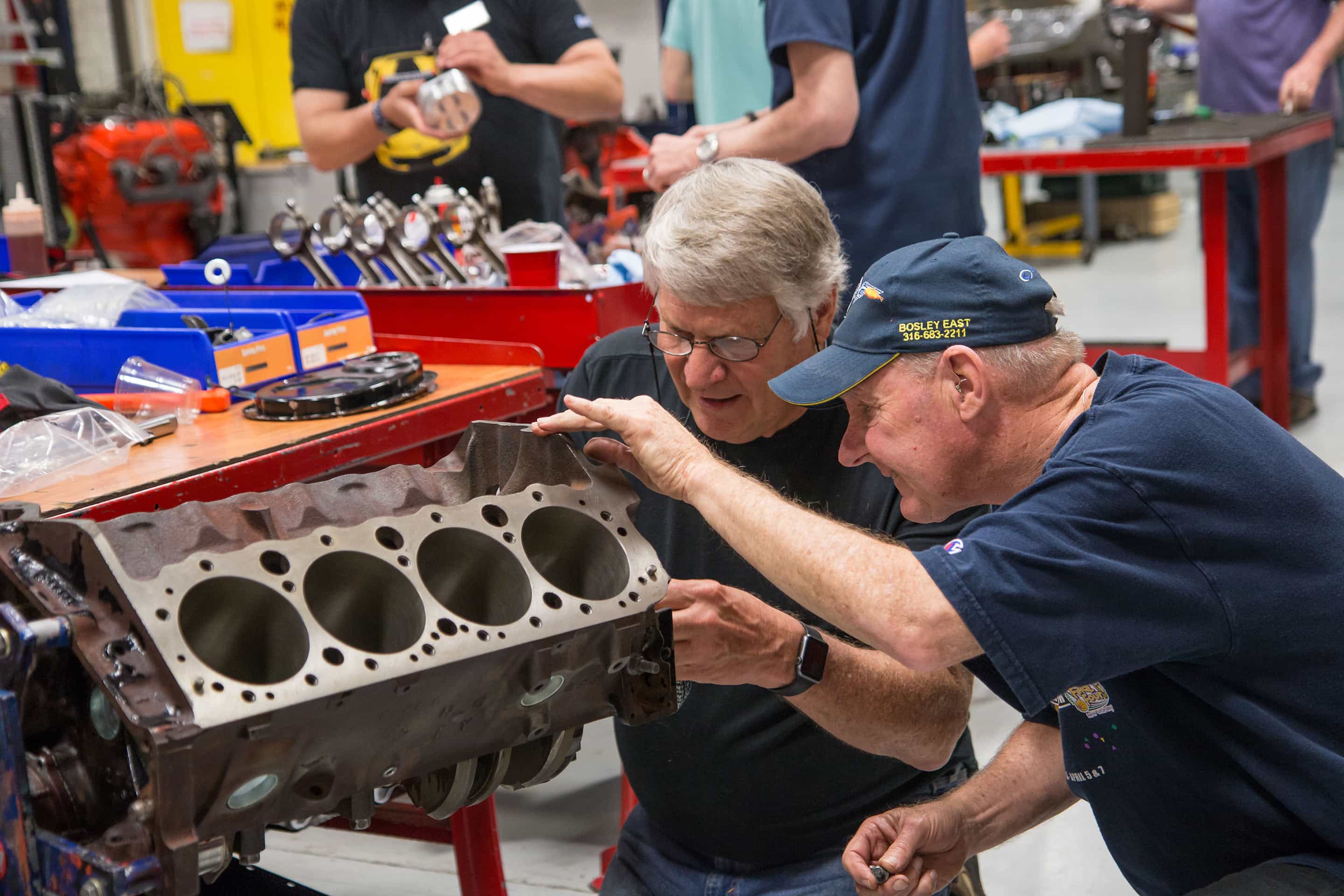Learn automotive restoration skills in convenient workshops at the Automotive Restoration Institute.
About the Institute
The same expert instructors and top-notch facility that has made McPherson College’s Automotive Restoration Program famous are available to hobbyists and professionals.
Each class concentrates on a specific skill area and is 5 days in length. You learn restoration by doing restoration with hands-on experience. Due to the hands-on nature of the classes, participants will spend full days in the class and may only take one class per week.
Enrollment in each class is limited so all participants benefit from the personal attention of our expert instructors with ample time on the equipment. With this one-on-one approach, no matter what level of skill you have, you will increase your restoration expertise.
Classes include valuable information on locating tools, materials, and parts. In many cases, you can bring parts from your current restoration project to work on.
2024 Summer Class Registration to open November 16, 2023 at 9 am central time.
2024 Institute RegistrationCONTACT
Brian Martin
[email protected]
Office 620-242-0428
Cell 620-480-9278
2024 Schedule
Week 1 June 3-7
Course/Instructor
- Drivetrain, Cory Unruh
- Electrical, Sam Babb
- Engine Rebuilding, Curt Goodwin
- Machining, Garrick Green
- Paint, Chris Clark
- Sheetmetal, Ed Barr
- Small Parts Reproduction, Chris Paulsen
- Upholstery & Trim, Mike Dudley
Week 2 June 10-14
Course/Instructor
- 3-D Design, Cory Unruh
- Applied Trim & Upholstery, Mike Dudley
- Babbiting, Chris Paulsen
- Paint, Chris Clark
- Sheetmetal, Ed Barr
- Tune-Up, Curt Goodwin
- Woodworking, Garrick Green
Week 3 June 17-21
Course/Instructor
- Advanced Paint*, Chris Clark
- Advanced Sheetmetal*, Ed Barr
- Applied Trim & Upholstery, Mike Dudley
- Brakes, Luke Chennel
- Drivetrain, Cory Unruh
- Engine Rebuilding, Curt Goodwin
- Machining, Garrick Green
- Understanding Early Automobiles, Chris Paulsen
*Denotes classes that require a participant has taken the intro class either this or a previous term.
Costs
- Class: $1,075 per class, including lunch
- Meal Plan: $200 to add breakfasts and dinners
- Dorm: $275 for a single room including bedding and linens
*If attending consecutive weeks, the dorms will be available for use over the weekend between those classes. - Shuttle: $25 per person (each way to and from the Wichita airport)
- Cancellation fee:
$100 per class
$250 per class, after April 12, 2024
Forfeit cost of class after May 24, 2024
Classes
These classes are designed for hobbyists and beginners of all ages and interests. Everyone comes with different skill levels and knowledge so they will build from the basics. Classes will start with brief histories and fundamentals of the knowledge needed but the goal is to get students into the labs as soon as possible and start doing.
3-D Design and Printing
Participants will learn how to produce parts utilizing Onshape 3D design software. The necessary steps to reproduce rare, nonexistent and custom parts will be covered. We will utilize 3D printers, but will also look at other fabrication processes. Each student will have the opportunity to design parts and tools that will then be 3D printed. The projects include dimple dies, stamping/forming dies, fuel pump block off plate, tap holder and custom air filter housing. Students are also welcome to work on designing their own personal projects. No prior 3D modeling or 3D printing experience is necessary. The major topics covered include:
- 3D printer and slicer basic operation
- Designing, printing and preparing patterns for sand casting and lost PLA investment casting.
- Designing metal shaping tooling including dimple dies, forming dies, and bead roller dies.
- Design parts that can then be produced utilizing CNC fabrication processes such as milling,plasma cutting, routing, etc.
- 3D printer and filament types
Applied Automotive Trim & Upholstery
Participants in this class will spend their week exclusively in the trim lab fine-tuning their automotive trim and upholstery skills. Because of the expectation that participants have sewing and upholstery experience before enrolling in the class, it is requested that participants will have taken the fundamental Automotive Trim and Upholstery class previously.
It is encouraged that participants bring a personal automotive trim project from home for this week, but it is not required.
Lab demonstrations and guidance during the week will be tailored to participant’s projects as needed.
Automotive Electrical
 Discover the fundamentals of automotive electrical systems. Gain knowledge of the use of basic electrical tools such as voltmeters, ammeters, and multimeters. Included in the class is an introduction to oscilloscopes for advanced diagnostics. Explore and practice diagnostics, troubleshooting, and repair of automotive DC circuits. Learn by hands-on practice finding opens, shorts and miswired circuits, etc. Also, repairs of starters, generators, alternators, spark ignition systems, and wiring. Learn and understand the necessary theory of current, voltage, and Ohm’s law to diagnose and repair these components. Gain an understanding of electricity without complicated math or mythology.
Discover the fundamentals of automotive electrical systems. Gain knowledge of the use of basic electrical tools such as voltmeters, ammeters, and multimeters. Included in the class is an introduction to oscilloscopes for advanced diagnostics. Explore and practice diagnostics, troubleshooting, and repair of automotive DC circuits. Learn by hands-on practice finding opens, shorts and miswired circuits, etc. Also, repairs of starters, generators, alternators, spark ignition systems, and wiring. Learn and understand the necessary theory of current, voltage, and Ohm’s law to diagnose and repair these components. Gain an understanding of electricity without complicated math or mythology.
Automotive Woodworking
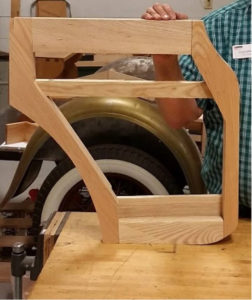 Automotive woodworking usually involves replacing sections of rotted wood on pre-‘30s cars or making a “woodie” from scratch. This class will focus more on the wood replacement topic than scratch-building a body, but most techniques used for the former also apply to the latter.
Automotive woodworking usually involves replacing sections of rotted wood on pre-‘30s cars or making a “woodie” from scratch. This class will focus more on the wood replacement topic than scratch-building a body, but most techniques used for the former also apply to the latter.
During this class, we will make a 1929 Stutz Blackhawk rear door frame from plans (a project representative of most construction in automotive coachwork from pre-1930). This project will require project planning, material selection, glue-ups, woodworking machines, hand tool use, and finishing. The completed door frame will be perfect for making a skin in advanced sheet metal, by the way. No previous woodworking experience is necessary.
Brake Systems
Learn how to properly restore mechanical and hydraulic brakes. Students will gain experience with a number of different kinds of brakes, including external contracting drums, internal expanding drums, and disc brakes. Both mechanical and hydraulic systems will be discussed, including the proper adjustment of mechanical systems, relining, arching, and centering shoes, and common brake system modifications. Students will learn the proper techniques for rebuilding master cylinders, wheel cylinders, and disc brake calipers. We will discuss historical development of brakes from the earliest shoe-type brakes to contemporary modern 4-wheel disc systems, including some unusual and different approaches to stopping a vehicle. In the shop, students will learn the necessary skills to ensure a vehicle stops properly every single time.
Day 1: Introduction to braking systems, fundamentals of hydraulics, friction systems, history of brakes. Lab: Mechanical braking systems, adjustment and rebuilding.
Day 2: Hydraulic valves and switches, fluids and sealing systems, brake bleeding. Lab: fixed-anchor brakes, adjustment and care.
Day 3: Drum and Disc Brakes, Operation and Overhaul. Lab: Bendix-style self-energizing brakes, operation and rebuilding.
Day 4: Wheel bearings, parking brakes, brake boosters. Lab: Disc Brakes: rebuilding, care and adjustment.
Day 5: Wrap-up, conclusions, open lab time.
Drivetrain
This class starts with the theory and operation of drivetrain components including: clutches, manual transmissions, drive shafts, differentials and rear ends. After covering the functioning principles students will have the opportunity to go through the rebuilding process in the lab. Provided lab projects cover a wide range of years and technologies (1920’s – 1970’s and beyond). Participants also have the opportunity to bring in personal drivetrain components that they can work on during lab time. Throughout the week we will cover disassembly, cleaning, inspection, measurement, reassembly and setup for drivetrain components.
- Clutch assembly theory diagnosis, and repair
- Driveshaft and torque tube theory diagnosis and repair
- Manual transmissions – sliding gear to synchronized
- Rear end and differentials – Banjo to Hypoid rear ends
Engine Babbitting
Most engines produced before the mid-1930s used poured Babbitt bearings for their main bearings and connecting rod bearings. When done properly, rebuilt babbitted engines can be just as reliable today as they were when they were new.
In this course, we’ll cover the following: basics of Babbitting, different types of Babbitt, different types of equipment, removing old Babbitt, pouring main bearings, pouring rod bearings, machining main bearings, machining rod bearings, setting and cutting thrusts.
We’ll perform the above operations on two different engines, using a currently-produced modern set-up as well as original 1920’s Kwik-way equipment.
Engine Rebuilding
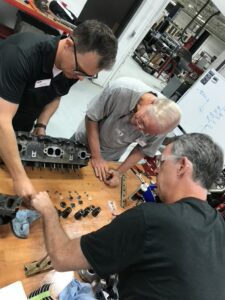 This is a hands-on engine rebuilding course designed around the hobbyist. The course will kick off with diagnosing engine problems focusing on mechanical issues to determine what repairs are necessary. Following diagnosis, correct disassembly, inspection, and measuring procedures will be covered in order to choose the proper machine shop operations. We will then correctly assemble the engines, inspect clearances, and make adjustments to factory specifications. The cap of the class will be running one of the engines we have rebuilt in the class focusing on proper setup, startup and break in procedures.
This is a hands-on engine rebuilding course designed around the hobbyist. The course will kick off with diagnosing engine problems focusing on mechanical issues to determine what repairs are necessary. Following diagnosis, correct disassembly, inspection, and measuring procedures will be covered in order to choose the proper machine shop operations. We will then correctly assemble the engines, inspect clearances, and make adjustments to factory specifications. The cap of the class will be running one of the engines we have rebuilt in the class focusing on proper setup, startup and break in procedures.
Engine Tune-Up & Diagnostic
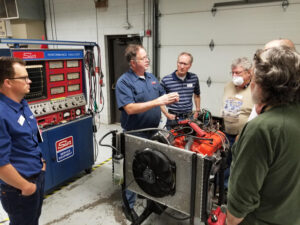
Learn how to get your classic running when it does not and keep it running the way it should! This class has three main diagnostic or repair topics: mechanical, ignition, and fuel system. The class will use mostly ‘60s engines for demonstration, but you will see that the technology transfers to generations of engines.
Starting with troubleshooting of the mechanical condition of the engine and verifying the mechanical integrity using compression and leak down testing, you will learn fundamentals that will be used for the rest of the week.
We will review the basic operation of the ignition system and how the components interact. Followed with diagnostics using an array of tools from engine scopes, digital multi meters, down to the basic test light. We will cover topics like how to inspect and adjust, ignition points, ignition timing, vacuum advance, and mechanical advance.
When the ignition is dialed in, we will cover the fuel system by learning the basic systems of the carburetor and how they work together to deliver the correct amount of fuel. Dissembling and reassembling carburetors, you will learn about bench adjustments and tips for repair. After this exercise we will install the carburetors to be adjusted and tested on a running engine. Learning how to use a gas analyzer and basic tools for adjustment will be also included.
Machining
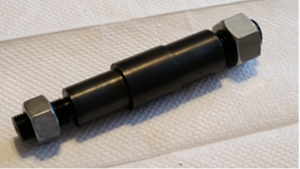 This class is designed to teach the basics of operating a toolroom lathe to make replacement parts for your project vehicle. The first day or two will be heavy on classroom time to build knowledge and transition to mostly machine-time as the week progresses. We will make at least three projects, which are representative of common repairs needed in restoration. No prior machining experience is required.
This class is designed to teach the basics of operating a toolroom lathe to make replacement parts for your project vehicle. The first day or two will be heavy on classroom time to build knowledge and transition to mostly machine-time as the week progresses. We will make at least three projects, which are representative of common repairs needed in restoration. No prior machining experience is required.
Your instructor for this class will teach you to:
- Use a Southbend toolroom lathe to make cylindrical parts – we will make: (1) a 5-step 4140 steel shaft with external threads on both ends, (2) a 2-step 4140 steel shaft with internal and external threads, and (3) a bronze bushing
- Precision measure with an outside micrometer, depth micrometer, Vernier caliper, Vernier height gauge, and telescoping gauges
- Grind a high-speed steel tool to use on the lathe
- Single-point thread on the lathe (including left-hand threads)
- Drill and bore on the lathe
- Power tap on the lathe
- Oxide surface-finish steel
- Read blueprint drawings
Paint
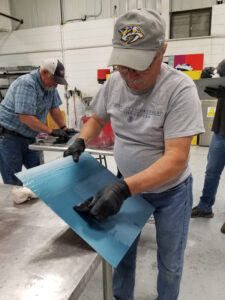 This class is designed to teach the fundamental principles in automotive paint application. Topics include sheet metal preparation, preparation of existing paints, application and use of primers, block sanding, application of topcoat paints, color/wet sanding, polishing, paint gun setup, air tool and compressor selection, and paint material usage on various parts of the automobile. Throughout the week, two test panels are painted with an emphasis on proper paint application techniques, which are administered through both classroom teaching and lab experience. The first test panel will be used for the application of single-stage paint, while the second test panel will be used for the application of basecoat and clear coat materials. This class aims to prepare participants to begin entry-level painting procedures and not larger, more advanced painting projects.
This class is designed to teach the fundamental principles in automotive paint application. Topics include sheet metal preparation, preparation of existing paints, application and use of primers, block sanding, application of topcoat paints, color/wet sanding, polishing, paint gun setup, air tool and compressor selection, and paint material usage on various parts of the automobile. Throughout the week, two test panels are painted with an emphasis on proper paint application techniques, which are administered through both classroom teaching and lab experience. The first test panel will be used for the application of single-stage paint, while the second test panel will be used for the application of basecoat and clear coat materials. This class aims to prepare participants to begin entry-level painting procedures and not larger, more advanced painting projects.
Advanced Paint
This class moves beyond the fundamental principles of paint application and into more advanced painting experiences. This class begins with taking an already painted test panel that is dented and/or scratched and making a repair using correct bodywork methods. The proper use of body filler and its application techniques are emphasized in this project. The refinish work on this panel will incorporate two-tone colors using proper tape and masking procedures and may also include the usage of metallic or pearl components. The latter part of the class will consist of a group(s) project provided by the college. The purpose of this class is to instill confidence and prepare participants for larger and/or more advanced projects upon returning home.
Sheetmetal
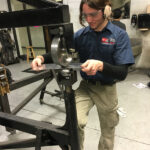
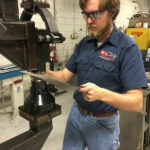 An introduction to the welding, cutting, and metal shaping processes used to repair antique automobile sheet metal. Learn oxy-acetylene welding, brazing, torch cutting, spot-welding, MIG and TIG welding, and plasma cutting. Explore metal shaping using hand tools, shrinker/stretchers, the English wheel, the power hammer, bead roller, and Pullmax machine. Dent repair, heat shrinking, lead body solder application, weld finishing, and patch panel fabrication/replacement are also covered.
An introduction to the welding, cutting, and metal shaping processes used to repair antique automobile sheet metal. Learn oxy-acetylene welding, brazing, torch cutting, spot-welding, MIG and TIG welding, and plasma cutting. Explore metal shaping using hand tools, shrinker/stretchers, the English wheel, the power hammer, bead roller, and Pullmax machine. Dent repair, heat shrinking, lead body solder application, weld finishing, and patch panel fabrication/replacement are also covered.
Advanced Sheetmetal
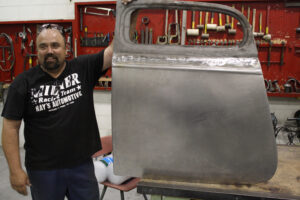 A highly individualized course of study for the serious hobbyist. Course content varies according to needs of participants. Topics covered typically include advanced metal shaping and fabrication techniques, copying shapes and making patterns, welding multi-piece panels. Extended time working on a personal project if desired. Must have taken Sheet Metal Restoration from Ed Barr. Students are encouraged to bring a project after consulting with instructor. Students who are unable to bring a project can work with the instructor to design a course of study that will best meet their needs prior to arriving on campus.
A highly individualized course of study for the serious hobbyist. Course content varies according to needs of participants. Topics covered typically include advanced metal shaping and fabrication techniques, copying shapes and making patterns, welding multi-piece panels. Extended time working on a personal project if desired. Must have taken Sheet Metal Restoration from Ed Barr. Students are encouraged to bring a project after consulting with instructor. Students who are unable to bring a project can work with the instructor to design a course of study that will best meet their needs prior to arriving on campus.
Small Parts Reproduction and Finishing Touches
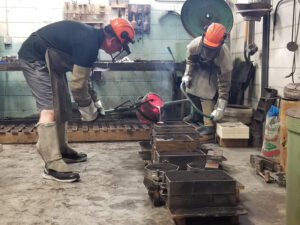 In this class, we’ll work on many of the projects that are required to complete the details of a total restoration. We’ll straighten bright work such as brass, copper, aluminum, and stainless steel. We’ll practice the buffing and polishing steps for the same bright work. We’ll practice different techniques for replicating wood-graining of the 1920s-1950s. We’ll perform various techniques for applying pin-striping. We will apply different types of plating-nickel, copper, and copy-cadmium. We will make simple patterns, sand molds, and cast parts in aluminum. We’ll reproduce plastic parts using rubber molds. All of these processes will be taught with the home hobbyist in mind. Participants are welcome to bring some parts in to work on. Please contact instructor for more information. Each topic will be demonstrated, then time allowed for participants to practice each. A survey will be sent to participants to assess interest in the different subjects in order to plan the week.
In this class, we’ll work on many of the projects that are required to complete the details of a total restoration. We’ll straighten bright work such as brass, copper, aluminum, and stainless steel. We’ll practice the buffing and polishing steps for the same bright work. We’ll practice different techniques for replicating wood-graining of the 1920s-1950s. We’ll perform various techniques for applying pin-striping. We will apply different types of plating-nickel, copper, and copy-cadmium. We will make simple patterns, sand molds, and cast parts in aluminum. We’ll reproduce plastic parts using rubber molds. All of these processes will be taught with the home hobbyist in mind. Participants are welcome to bring some parts in to work on. Please contact instructor for more information. Each topic will be demonstrated, then time allowed for participants to practice each. A survey will be sent to participants to assess interest in the different subjects in order to plan the week.
Trim and Upholstery
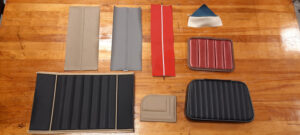 Participants will learn the fundamentals of automotive upholstery restoration and replacement. Industrial sewing machines will be used to learn the basics of constructing interior components such as seats (including various types of seams, piping, & seat cover styles) and door panels. To learn the construction techniques, a packet of sewing exercises will be given to each participant. The instructor will demonstrate each exercise and then participants will be given time in the lab to practice with the instructor’s guidance.
Participants will learn the fundamentals of automotive upholstery restoration and replacement. Industrial sewing machines will be used to learn the basics of constructing interior components such as seats (including various types of seams, piping, & seat cover styles) and door panels. To learn the construction techniques, a packet of sewing exercises will be given to each participant. The instructor will demonstrate each exercise and then participants will be given time in the lab to practice with the instructor’s guidance.
After the exercises are completed, participants will be given the opportunity to design and construct a small seat cushion. In addition to lab time, time will also be spent in the classroom going over the history and various materials and processes (e.g. upholstery fabrics, tools, foundations, pattern making, headliner installation) of automotive trim work.
Understanding Early Automobiles
This class will cover various topics related to early automobiles, through the early 1930’s. We’ll study their mechanics, history, technology, and lasting impact. We’ll explore what makes them go (and occasionally not go). The class will cover the basics of their working components – engine, transmission, fuel, ignition, steering, and brake systems. We’ll also talk about early auto history, and what makes it an important and fascinating part of car collecting. We’ll discuss their collectability and usability today. We’ll focus on the Model T Ford, but also look at and experience the 1886 Benz replica, 1902 Oldsmobile, Model A Ford, and others.
*Advanced classes require having taken the intro class
